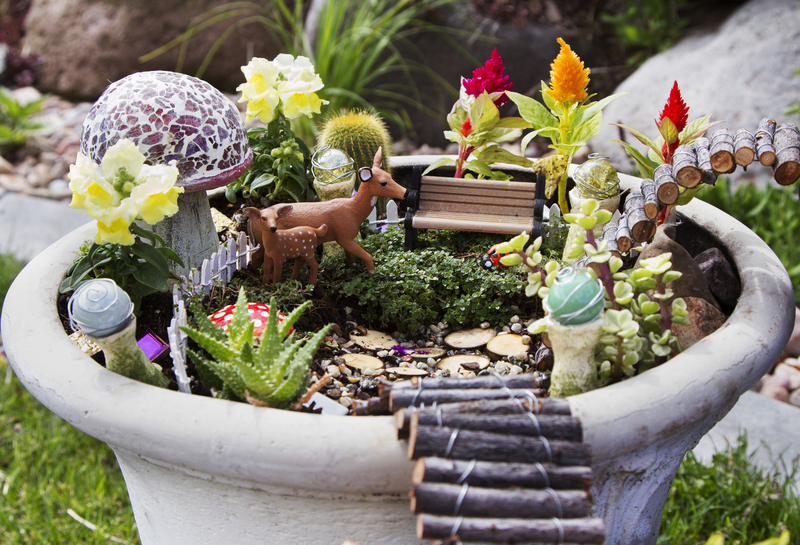Gardening Solutions for Coping with Intense Wind
Posted on 12/06/2025
Gardening Solutions for Coping with Intense Wind: Strategies for Windproof Gardens
Gardening in regions exposed to intense wind can be incredibly challenging. While wind is a natural part of the weather, powerful winds can cause significant harm to your plants, structures, and even soil. The good news? With the right gardening solutions and informed strategies, you can cultivate a healthy, beautiful garden that thrives even under the toughest conditions. This comprehensive guide to wind-resistant gardening will help you protect, nurture, and enjoy your green oasis despite the bluster.
Table of Contents
- Why Wind Is Challenging for Gardeners
- Selecting Wind-Resistant Plants
- Windbreaks and Barriers: Your Garden's First Line of Defense
- Design and Layout Tips for Windproof Gardens
- Protecting Soil and Mulches from Wind Erosion
- Caring for Plants in Windy Conditions
- DIY Gardening Solutions for Intense Wind
- Long-Term Strategies and Maintenance
- Conclusion
Why Wind Is Challenging for Gardeners
Intense wind poses several significant threats to gardens, including:
- Mechanical damage to plants, breaking stems and branches.
- Increased evaporation leading to water stress in soil and plants.
- Soil erosion, which strips away vital nutrients and exposes roots.
- Cooling effect, which can cause chilling injury even when temperatures are moderate.
- Pest and disease transmission, as wind can spread spores and infestations.
Understanding these challenges will help you plan an effective gardening response and choose the most appropriate wind-resistant gardening solutions.
Selecting Wind-Resistant Plants
The first step in creating a windproof garden is to select plants that naturally tolerate blustery conditions. Not all species are equally vulnerable to damage from wind gusts. Some plants have evolved in exposed areas, developing features that help them bend, rather than break, or minimize their surface area for resistance.
Characteristics of Wind-Tolerant Plants
- Flexible stems and branches, which can sway without snapping.
- Small, narrow, or waxy leaves to reduce water loss and drag.
- Deep or spreading roots for better anchorage.
- Compact, low-growing forms that reduce wind exposure.
Popular Wind-Resistant Plant Varieties
- Ornamental grasses such as miscanthus or pennisetum
- Evergreen shrubs like boxwood, juniper, or escallonia
- Tough perennials including lavender, yarrow, and sedum
- Wind-hardy trees such as rowan (mountain ash), hawthorn, or black locust
When planning your garden in a windy area, choose species adapted to local wind conditions and test new additions for their resilience.
Windbreaks and Barriers: Your Garden's First Line of Defense
A strategic windbreak is often the most effective gardening solution when it comes to mitigating the effects of intense wind. By creating sheltered zones, you'll protect sensitive plants, conserve moisture, and reduce soil loss.
Types of Windbreaks and Barriers
- Living windbreaks: Hedges, rows of shrubs, or trees that reduce wind speed and offer wildlife habitat.
- Structural windbreaks: Fencing, trellises, or garden walls constructed from materials such as wood, plastic, or mesh.
- Temporary barriers: Shade cloth, hessian, or plastic netting used during the windiest months or in emergencies.
How to Install Effective Windbreaks
- Position windbreaks at right angles to prevailing wind direction for maximum effectiveness.
- Aim for windbreaks with 40-60% permeability (such as a woven fence or layered hedge) to slow and diffuse rather than block wind entirely.
- Stagger plantings in layers -- tall trees at the rear, medium-height shrubs in the middle, and low-growing plants in front -- to create a graduated wind buffer.
- Leave enough space between windbreaks and main planting areas to minimize turbulence and allow air to settle gently in your garden.
Best Plants for Living Windbreaks
- Conifers such as cypress or pine (be mindful of allelopathy and root spread)
- Evergreen shrubs like holly, privet, or viburnum
- Bamboo (clumping types are usually preferred to avoid invasiveness)
- Laurel, olive, or native hedges
For urban gardens, vertical structures such as lattice panels draped with climbing plants (like clematis or ivy) offer an attractive, space-saving wind solution.
Design and Layout Tips for Windproof Gardens
When planning a garden in a windy area, thoughtful layout design is key. Smart garden planning not only shields plants but can also create microclimates, improving overall success for every gardener.
Garden Design Strategies to Minimize Wind Damage
- Cluster sensitive plants in the most protected corners.
- Use dense plantings to create wind-filtering effects throughout the plot.
- Position tall or brittle plants where windbreaks provide maximum shelter.
- Employ earth berms, raised beds, or sunken gardens to reduce exposure.
- Include hardscaping elements such as boulders, walls, and paths to alter wind patterns and channel breezes safely.
Creating Mini Microclimates
Establishing a mix of sheltered and open spaces can protect vulnerable species while allowing wind-loving plants to flourish where they shine best. Utilize courtyard gardens, alcoves, or pockets against existing walls for highly sensitive specimens.
Protecting Soil and Mulches from Wind Erosion
Soil erosion caused by strong winds can deplete your garden of vital organic matter and nutrients, undermining plant health. Here are some soil conservation tips suited for wind-prone gardens:
Soil Conservation Techniques
- Cover bare soil promptly with dense plantings, groundcovers, or organic mulch such as bark chips, straw, or shredded leaves.
- Use heavier mulches that are less likely to blow away -- wood chips, gravel, and rubber mulch are excellent options.
- Employ living mulches (such as clover or creeping thyme) between vegetable rows and under shrubs to keep soil protected year-round.
- Install edging or border materials to anchor mulches and prevent wind from lifting loose material.
- Utilize no-dig gardening approaches to minimize disturbance and maintain soil structure.
*Regularly check your mulched areas* after heavy winds and reapply as needed for continued soil windproofing.
Caring for Plants in Windy Conditions
Daily and seasonal plant care practices can make the difference between a struggling and a thriving wind-exposed garden.
Watering Techniques
- Water deeply and infrequently, encouraging deeper root systems less susceptible to surface drying.
- Water at the base of plants to conserve moisture and avoid wind-driven evaporation.
- Mulch generously to further slow evaporation and keep roots cool.
Staking and Supports
- Use sturdy stakes and ties for young trees and tall plants, but ensure some movement is possible for natural strengthening.
- Prefer guy wires or angled stakes for very exposed positions.
- *Check supports regularly* for wear and avoid excessive tightness, which may damage growth.
Seasonal Pruning and Maintenance
- Prune trees and shrubs to maintain balanced, open shapes that let wind pass through more easily.
- Remove weak or damaged limbs that could break off in storms.
- Deadhead and thin out dense flower spikes and foliage in late spring and summer to reduce wind resistance.
Tip: Frequent inspections help you catch wind-related harm early, allowing fast intervention before lasting damage occurs.
DIY Gardening Solutions for Intense Wind
Gardeners on a budget can implement a wealth of creative, low-cost windproofing tactics. Here are a few DIY gardening hacks for wind protection:
- Create instant windbreaks using recycled pallets, woven willow, or old sheets attached to posts for temporary protection after transplanting.
- Wrap new plants and vulnerable vegetables with cloches, plastic bottles, or wire cages until established.
- Construct mini-tunnels or frames over raised beds with hoop supports and horticultural fleece for young seedlings.
- Fill containers with heavier soil mixes or anchor pots with hidden stones to prevent toppling in high winds.
- Use old carpet or heavy-duty fabric squares as temporary mulch on exposed vegetable patches during windy spells.
*For coastal or mountain gardens, implement several DIY solutions together for layered security against unpredictable gusts.*
Long-Term Strategies and Maintenance
Resilient gardens require ongoing attention. Over years, focus on building stronger ecosystems that are self-sustaining under wind pressure.
Continuous Improvement for Windproof Gardens
- Add and diversify windbreaks as your garden matures, and periodically strengthen existing barriers.
- Rotate sensitive crops and adjust layouts as wind patterns shift or as new construction/land changes affect airflow.
- Regularly replenish and improve soil health using green manures, compost, and deep mulching techniques.
- Monitor plant varieties for wind tolerance and gradually favor those that prove robust in your specific conditions.
Building a Wind-Resistant Gardening Culture
- Network with neighbors for shared windbreaks between properties.
- Keep a weather log to identify yearly wind trends and better plan future planting and construction.
- Educate new gardeners in your community about the value of wind-smart planting and care.
When to Seek Expert Advice
If repeated wind damage occurs despite your best efforts, consult with local horticulturalists, arborists, or extension agents. They can offer tailored solutions for your unique location.
Conclusion: Embracing Wind as Part of Your Garden's Story
While coping with intense wind presents undeniable gardening challenges, it also provides an opportunity to enhance your landscape's resilience and beauty. By selecting the right plants, installing smart windbreaks, designing for shelter, and practicing sound maintenance, your garden can flourish even in the windiest microclimates.
Remember: Gardening in the wind is a journey of adaptation. With patience, creativity, and the right knowledge, your lush, wind-resistant retreat can inspire others and serve as a living demonstration of nature's enduring strength.
Ready to get started? Choose a gardening solution from this guide that fits your conditions and take the first step toward a greener, more resilient landscape today.



